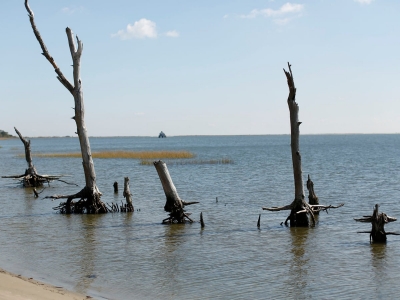
Scientists at the Duke University and the University of Virginia have recently documented how sea-level rise in triggering forest die-offs in coastal regions. Studying the vegetation in North Carolina, they find that rising seas are inundating the State’s coast, and the saltwater is seeping further into the land and wetlands. This salt is killing huge swaths of contiguous forest, which the scientific community calls ‘ghost forests’. Using satellite images, they have shown that more than 10% of forested wetland within the Alligator River National Wildlife Refuge in North Carolina have been lost over the last 35 years. They point out that the widespread loss of forests has cascading impact on wildlife. Ghosts forests have been witnessed in other parts of the world too.
What is sea-level rise?
Sea-level rise is an increase in the level of the world’s oceans due to the effects of global warming. The rise in sea levels is linked to two primary factors…
Thermal expansion:
The oceans are absorbing more than 90% of the increased atmospheric heat associated with greenhouse gas emissions. When water heats up, it expands. The ocean water expands and takes up more space. This is called expansion, and it is responsible for one-third of the sea-level rise.
Melting of glaciers and ice caps:
Warmer temperatures cause land-based ice such as glaciers and ice sheets to melt, and the meltwater flows into the ocean to increase sea level. Melting ice causes about two-thirds of the rise in sea level.
In 2019, a study projected that in low-emissions scenario, sea level will rise 30 cm by 2050 and 69 cm by 2100. In high-emission scenario, it will be 34 cm by 2050 and 111 cm by 2100. In the worst-case scenario – in which the planet heats up by 5 degrees Celsius in the next 80 years – melted ice could raise sea levels worldwide by more than 198 cm, according to another study published in May 2019.
Impact of sea-level rise on coastal region
- The impact of sea-level rise includes flooding, habitat destruction, soil erosion, and disappearance of low-lying islands. Rising sea levels also made storm surges capable of much greater damage. (Storm surge is the abnormal rise in seawater level during a storm. Storms surge can penetrate well inland.) Higher sea levels are coinciding with more hurricanes, contributing to more powerful storm surges that can strip away everything in their path.
- Many birds use coastal ecosystems to find food, live, and breed. Sea turtles lay their eggs on beaches returning to the same location every year. When beaches erode, these animals and birds will be affected.
- Rising sea levels will lead to the displacement of people. It could create 187 million climate refugees by 2100, according to a study.
About ghost forests
Rising seas often conjure the threat to faraway, low-lying nations, coastal cities or island-States sometime in the future. But the fact is the effects are already being felt by coastal vegetation. Ghost forests, which are landscapes filled with ghostly dead trees, are the immediate consequences of sea-level rise. These leafless, limbless trees can last decades in this dried-up barren state.
Sea-level rise connection
Sea-level rise increases the risk of saltwater intrusion. It is the flow of seawater into wetlands and rivers. As sea level rises, more and more saltwater encroaches on the land and overtakes freshwater that trees rely upon for sustenance. The salty water slowly poisons trees and eventually kills them. (Dead trees with pale trunks are a telltale sign of high salt levels in the soil.)
The rising salt water also leaves soil unhealthy and forests unsuitable for new growth. What scientists witness is that, while large patches of trees are dying simultaneously, saplings of the same species aren’t growing to take their place. Instead, shrubs and grasses that are more salt-tolerant are moving in to take their place.
Scientists also note that extreme weather events, fuelled by climate change, are causing further damage to vegetation in the form of heavy storms, more frequent hurricanes and drought. This is causing mass tree die-offs across coastal regions.
Picture Credit : Google



